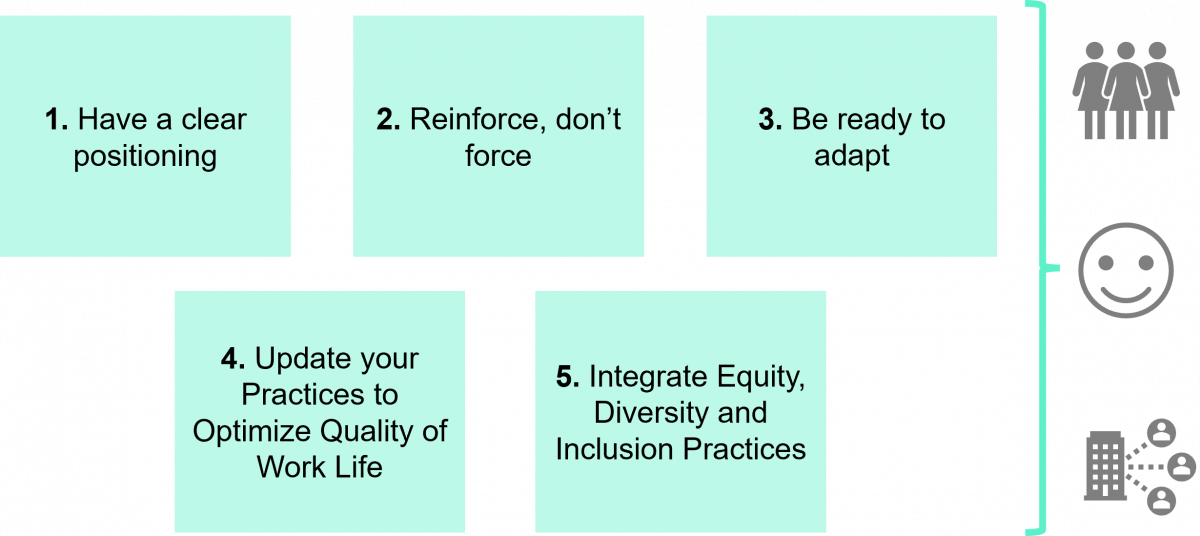Carbon Accounting Management Platform Benchmark…

Sia Partners shares 5 golden rules to maximize the employee experience and foster retention in a hybrid work environment.
As employees, we all have expectations regarding our company, management, HR, colleagues, and work. The pandemic has shown no mercy, we are all feeling the impact on our health, both psychological and physical. As the line between work and personal life blurs, employees are beginning to reflect on the following question: why should I stay?
As many employees are being courted by other organizations, it is becoming more and more difficult to resist the temptation to jump ship in search of a better work-life balance.
In this context, where attracting and retaining talents are part of our daily challenges, we must ensure that we take concrete actions to foster a positive experience for employees. This challenge magnifies the difficult constraints highlighted by the global pandemic, the return to the office, and the hybrid work environment.
In order to stay relevant in this ever-evolving labour market, Sia Partners offers five golden rules to follow for a successful transition.

Uncertainty often contributes to a feeling of discomfort, Maslow highlighted the fundamental need for security in his Pyramid. It can therefore be destabilizing to consider returning to the office in person, especially if an organization is slow to take a position on return-to-work terms and conditions.
Over the past several months, our living and working habits have changed significantly. From the perspective of sound management around this transformation, a clear positioning will reassure employees and allow everyone to prepare for this new reality.
Here are a few practices you can put in place to ensure a clear positioning:
No one likes to be forced or have a decision imposed on them. Employees prefer to be involved and considered in the choices. That said, an interesting approach to ensure a smooth return to the office is to rely on positive reinforcement, to avoid forcing employees to come back to the office, but rather offer them incentives to do so. To identify the appropriate incentives, using Design Thinking could be a great opportunity, especially since this is a perfect time to be imaginative and innovative!
Here are a few practices you can implement to encourage office attendance:
Time will not necessarily make things better! Since the return to the office is a major change, a good practice is to equip and support the members of the organization to make this transition more fluid and pleasant.
Here are some ideas for developing your support initiatives:
Quality of work-life (QoWL) is a factor that has a significant influence on the attraction, retention, engagement and performance of employees. More awareness on the subject has been precipitated by the pandemic, which has highlighted the need for QoWL, as proven by the Ontario government's recent law on the right to disconnect and Portugal's recent law banning managers from contacting employees out of work hours.
Here are some examples of actions you can take to update your QoWL practices:
Finally, why not create an exchange network between professionals? After all, we all face similar issues.
Numerous studies from the Harvard Business Review show that flexible work can have the effect of disrupting work-family harmony. Indeed, working from home can sometimes make it difficult to set boundaries. Another finding is that women take on more domestic responsibilities when working from home, while men tend to prioritize their work activities (Ibarra, Gillard, Chamorro-Premuzic, 2020).
On the other hand, employees with a more sustained office presence are likely to be privy to informal information and conversations. This reality may disadvantage those working remotely and thus, cause issues around equity and inclusion.
Here are some practices to promote equity and inclusion in this context:
It is utopian to think that the return to work can be done in the same conditions as pre-pandemic. Many changes have taken place since then, and organizations must adapt and evolve to remain competitive.
With the number of departures increasing, why wait to revisit your internal practices? Don't underestimate the power of clear, well-publicized communication based on listening to your people.